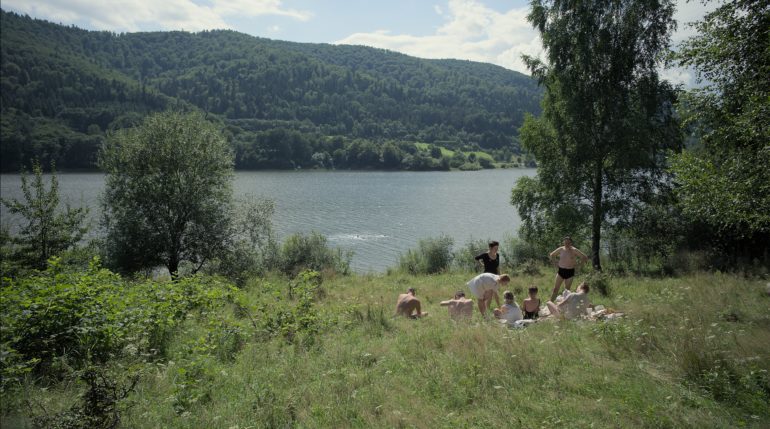It takes a great artist to make you look at a subject you thought you knew all about in a new light. The Zone of Interest confirms that writer-director Jonathan Glazer is a great film artist. As time increasingly separates us from history, the lessons it offers threaten to be forgotten. It doesn’t help that the portrayals of history offered by art can fall into predictable patterns. The Zone of Interest isn’t a prestige drama in the vein of Schindler’s List or The Pianist, nor is it a chronicle of the testimonies of the victims (If you want something like that, you have Shoah, or try Steve McQueen’s offering at Cannes this year, Occupied City). You’re going to get something very different here.
The defining feeling around The Zone of Interest is claustrophobia. This can’t be a surprise, as the home of Nazi commandant Rudolf Höss (Christian Friedel) and his wife Hedwig (Sandra Hüller) is a site of unbearable oppression in so many ways. Before we even venture outside this house Glazer, along with the production design and his DoP Łukasz Żal (He of the sterling marbled chiarascouro in Pawlikowski’s Cold War) create a passage tomb of narrow hallways and polished-but-rigid decor. The inhabitants rush down these halls as if seeking an escape. But there is no escape, and when they venture in the garden, we see why. The handsome green lawns and rose bushes are backgrounded by the towering walls of Höss’ despicable workplace, Auschwitz. Once this setting is established, the rest of The Zone of Interest concerns itself with one question: how? How does one potter in the garden when you’re next to what will become the greatest crime ever committed against humanity? Sadly, the answer is that the Höss family and their guests are all too aware. Freely adapting the novel by the recently-departed Martin Amis, Glazer removes all superfluous plotting to focus on the family, and their shocking lack of guilt. They go through their day, chores and busyness, while having to talk over the constant rumble of the crematoria and the occasional ripple of gunfire. Hannah Arendt’s proposition of the ‘banality of evil’ proves as powerful as ever. It helps that the film was shot at the real location. The house, the wall and the past are all horrifyingly present and correct.
Considering the examples of the Holocaust on film mentioned before, veering between heartbreaking testimony and forceful-yet-stylised violence, Glazer hits on a novel middle ground for his approach. We never get to see the acts perpetrated against the prisoners of the camp. Like a great horror film, it leaves the audience’s imaginations to fill in the gaps. When Hedwig’s mother visits, the two sit in the garden admiring their home, all the while competing to be heard with the rumble of the infernal death machine behind them. Höss discusses the efficiency of crematorium design with his superiors like a factory owner contemplating business expansion. Trying to understand such evil is as taxing for our minds as the barbarity it leads to. The Höss family’s POV brings home how perfidious the Nazi’s hatred of the Jewish people had become. The Höss’ sons play with dentures retrieved from the crematoria, while Hedwig admonishes her Jewish housekeeper with a threat to spread her ashes in the mud. Between this chilling role and her towering central performance in Justine Triet’s Anatomy of a Fall, Hüller is coming out of the Cannes Film Festival being rightfully recognised as one of the best actresses working today.
As disturbing as these displays of domesticated hatred are, Glazer employs a few other tactics to ensure the audience gets the message. For a while, it seems the director of Under The Skin has made his camera and storytelling fitting banal. Then, when we least expect it, we get scenes shot like night vision, as a young girl roots in the dirt of the camp under the cover of darkness. Her purpose is not immediately clear but, like the scenes of abduction and doom in Under The Skin, they purposefully disorient an audience still trying to grasp the mindsets of the inhabitants of this grim world. The Zone of Interest has a sense of style, but it’s never in service of anything except the truth of the situation. By the end of the film, Glazer’s choices seem to overwhelm even his characters. Höss leaves a meeting of high-ranking officers, and feels ill in an empty hallway. He looks into the darkness, and then comes a cut that must be one of the most extraordinary in recent cinema. Moments like this mark The Zone of Interest as a most daring and unforgettable experiment. It is a film about monstrosities, but it features no monsters, only humans at their most vile, and that’s probably worse. After Höss recomposes himself, the credits roll in and Mica Levi’s accompanying score leaves you in no doubt how to feel. The Zone of Interest masterfully burrows into the mind to infect it with the truth of the human capacity for cruelty. Try forgetting that any time soon.

